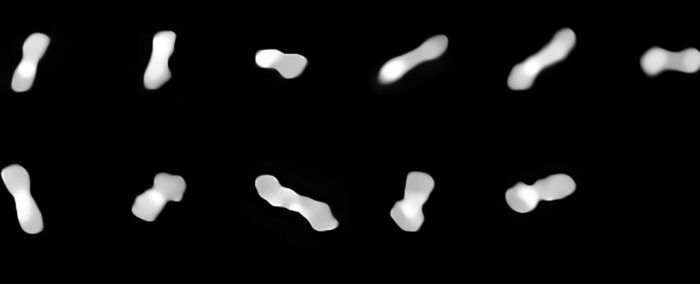When it comes to the solar system, asteroids can be treated as a bit of an afterthought. After all, you're up against planets, moons, dwarf planets, comets, not to mention the Sun! Who cares about a bunch of space pebbles, right?
But asteroids are not only extremely numerous (there's approximately 150 million of them measuring 100 metres or bigger), they're also quite diverse. Every one of them has their own story to tell. How they were formed. What they're made of. What part of the system they came from. It's pretty fascinating stuff!
To prove it, let's look at an asteroid named 216 Kleopatra. Though it gets its name from the famous Egyptian queen Cleopatra, the asteroid has less in common with royalty and more in common with ... dogs. You see, its unique shape—two large lobes at either end with a more narrow middle—has given it another nickname: the dog-bone asteroid!
Fetching information

"Here I am!" The orbit of Kleopatra in our solar system. (Wikimedia Commons)
It's a pretty cool object, and it raises some interesting questions. Namely, How does an asteroid like that get made? Scientists have been wondering the same thing, so they decided to use the new SPHERE instrument attached to the Very Large Telescope (yes, that's its real name!) in Chile. While they were at it, they also observed Kleopatra's two very small moons, AlexHelios and CleoSelene.
First, let's look at the basics. Kleopatra is found in the Asteroid Belt, located between Mars and Jupiter. It is about 270 kilometres (168 miles) long and rotates in a motion where the asteroid sort of tumbles over itself. So far, so good. But then the scientists stepped up their game, using newly accurate readings of the orbits of the two moons to calculate Kleopatra's mass (or how much matter it contains).
And what they found makes it less a dog-bone asteroid than just a pile of bones!
Just holding it together

An image of Kleopatra and its two moons. (ESO/Vernazza, Marchis et al./MISTRAL algorithm [ONERA/CNRS])
The density of an object affects its gravity. Very dense, high mass objects (with a lot of matter packed into a small area, like black holes) have high gravity. The lower the mass of an object, however, the lower the gravity.
By looking at the orbits of these moons very closely, researchers found that Kleopatra was almost half the mass they originally thought! What does this mean? The best guess is that Kleopatra is porous, or kind of full of holes and empty space. In other words, low density.
In fact, instead of being one solid chunk, it could only be a collection of many smaller rocks that have come together to form this unique shape. If this is true, then AlexHelios and CleoSelene are probably just a pair of rocks that used to be a part of Kleopatra until they fell away from the group and began orbiting around them.
Ultimately, more studies will need to be done to fully understand what Kleopatra is and how it came to be. But it's a perfect example of how intriguing any one of the asteroids within our solar system can be.
 Wheeee! These images show the many steps of the tumbling rotation of 216 Kleopatra. (ESO/Vernazza, Marchis et al./MISTRAL algorithm [ONERA/CNRS])
Wheeee! These images show the many steps of the tumbling rotation of 216 Kleopatra. (ESO/Vernazza, Marchis et al./MISTRAL algorithm [ONERA/CNRS])









